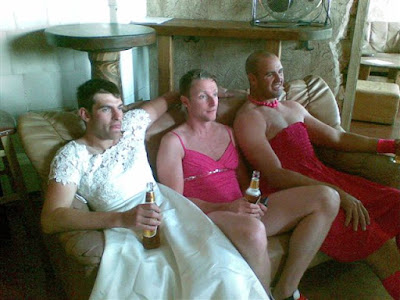Whats in a name ?
Anyhow to the news, as I mentioned a few weeks back a new Pub is opening, actually as of yesterday it has opened. Owned by M...(Swedish web man) and staffed by I..... ( Latvian - ex de Laceys, Stella/Star) + other former Paddy Whelans bar type person(s)had its official opening last night at 7.00pm.
Located in what was the Stella Pub in Dome Square, it has been decorated in rustic red, including the toilets, which many of who will remember for there colorful graffiti - Multiple television screens and all new tables and chairs. Being the first night it was a little chaotic, however it did have my favourite beer, but to be honest it seemed a little lacking in pub atmosphere.
It was bit like stepping into a new house, everything is there but it lacks a lived in look.
Clearly over time this will hopefully change, and it will develop its own character - we will but see.
As for the name Alberts, well it transpires he was the first bishop of Riga and indeed founded what we now know as Riga - history lesson to follow

Albert of Riga or Albert of Livonia (Latvian: bīskaps Alberts; German: Albrecht von Buxthoeven; c. 1165 in Bexhövede, a part of Loxstedt – 17 January 1229 in Riga) was the third Bishop of Riga in Livonia. In 1201 he founded Riga, the modern capital of Latvia, and built the city's cathedral in 1221.
Albert headed the armed forces that forcibly converted the eastern Baltic region to Christianity, in the nature of a crusade that was undertaken while the Fourth Crusade was sacking Constantinople.
Albert and his brother Hermann were members of the powerful Buxhoeveden family from Bexhövede, now a part of Loxstedt, Lower Saxony. Because of this he has also been known as Albert of Buxhoeveden (or Bexhövede, Buxhövden, Buxhöwde, Buxthoeven, Appeldern).
Albert was a canon in Bremen when his uncle Hartwig, Archbishop of Bremen and Hamburg, named him Bishop of Livonia (today Latvia and southern Estonia), provided that he could conquer and hold it, and convince the pagan inhabitants to become Christians. The patent was granted March 28, 1199, and by the beginning of spring 1200 he embarked with a Baltic fleet of 23 vessels and more than 1,500 armed crusaders. He had the support of the Hohenstaufen German King, Philip of Swabia, and the more distant blessing of Pope Innocent III.
Together with merchants from the Baltic island of Gotland, Albert founded Riga in 1201, where a small community of Hanseatic traders from Lübeck held a tentative trading encampment. He successfully converted many Livs under their leader Caupo, offering them protection against neighboring Lithuanian and Estonian tribes; Albert also converted some Latvians later on. The conquest of Livonia in full occupied almost three decades of his life.
Albert created a military order, the Livonian Brothers of the Sword, and began to build his cathedral in 1215. King Philip made him a Prince of the Holy Roman Empire, with Livonia for a fief, and thus Albert became a "Prince-Bishop". In 1225 King Henry VII of Germany confirmed the title of Prince for Albert and his brother, Hermann. Albert declared his diocese independent of Bremen, and later Riga was raised to an archbishopric.
A first-hand account of Albert is in the contemporary Chronicle of Henry of Livonia (Henricus Lettus').
Albert died in Riga in 1229, but, as a Catholic Bishop, left no descendants. He was venerated as a Catholic saint until the Protestant Reformation. The present-day "von Buxhoeveden" are descendants of his cousin Johannes von Buxhoeveden. Albert's brother Theodoricus is the progenitor of the family de Raupena (de Ropa, known today as "von der Ropp") that founded manors in Livonia and Courland.
A street in Riga, Alberta iela ("Albert Street"), is named after Bishop Albert. It is known for its Art Nouveau apartment buildings, many of them designed by the architect Mikhail Eisenstein.
Not sure what he would thought about having a pub named after him.
The weather for much of this week has been overcast, however the threatened bad weather had failed to materialise, indeed as I write the sun is shining and the annual Ligo Fair in Dome square is basking in the sunshine with all sorts of Latvian goodies for sale, including being to buy what looks like half a tree which you must wrap around your head on Ligo. I know Latvia has acres of forest, but at this time of the year they must take quite a hit.
and finally take a look at these images, taken buy one of many roving reporters - thanks A.... ( English - with south western accent)
See Anything strange ?
Anything Yet ??
Got it yet ?
Now you are getting it
Now you have got it - but the real question is what are they putting up ? and how did they get down ?
As ever Riga will be deserted next week with Ligo and Jani - so lets hope the sunshine stays and we get hot days and warm nights - but history tells us otherwise.








